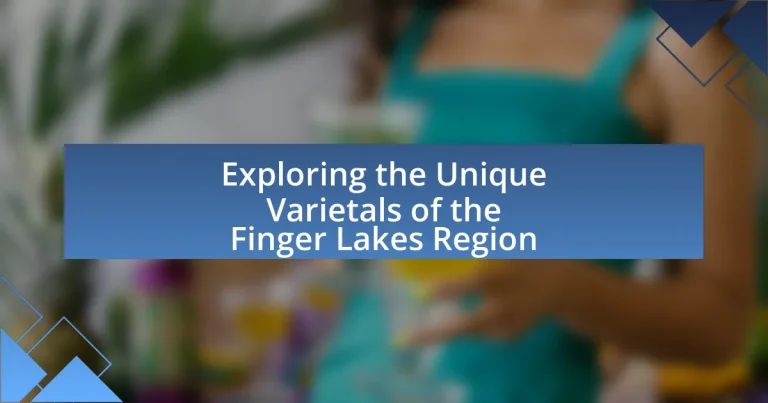The Finger Lakes Region is renowned for its unique varietals, including Riesling, Gewürztraminer, and Cabernet Franc, which thrive in its cool climate and diverse microclimates. The article explores how the region’s climate, geography, and topography influence grape cultivation, resulting in high-quality wines that express the local terroir. It also highlights the best practices for exploring these varietals, including winery visits and tastings, as well as the impact of climate change on grape production and consumer preferences. Additionally, the article discusses notable wineries, food pairings, and events that celebrate the region’s wine culture, providing insights into the future trends shaping Finger Lakes varietals.

What are the Unique Varietals of the Finger Lakes Region?
The unique varietals of the Finger Lakes Region include Riesling, Gewürztraminer, and Cabernet Franc. Riesling is particularly notable, as it thrives in the region’s cool climate, producing wines that are aromatic and balanced with acidity. Gewürztraminer, known for its floral and spicy notes, also flourishes in this area, contributing to the diversity of white wines. Cabernet Franc, a red varietal, is recognized for its ability to express the terroir of the Finger Lakes, showcasing flavors of red fruit and herbal undertones. These varietals are supported by the region’s unique geology and microclimates, which create ideal conditions for viticulture.
How do the climate and geography influence these varietals?
The climate and geography of the Finger Lakes Region significantly influence the varietals grown there by creating a unique microclimate that supports diverse grape cultivation. The region’s cool climate, characterized by warm summers and cold winters, allows for the production of high-acid wines, which are ideal for varietals like Riesling and Gewürztraminer. Additionally, the presence of the lakes moderates temperature fluctuations, providing a stable environment that enhances grape ripening and flavor development. This geographical feature contributes to the region’s reputation for producing award-winning wines, as evidenced by the Finger Lakes being recognized as one of the top wine regions in the United States, with over 100 wineries and numerous accolades for its varietals.
What specific climate conditions are present in the Finger Lakes?
The Finger Lakes region experiences a humid continental climate characterized by warm summers and cold winters. This climate is influenced by the large bodies of water in the area, which moderate temperatures and create a unique microclimate conducive to agriculture, particularly viticulture. The region receives approximately 30 to 40 inches of precipitation annually, with a significant portion occurring during the growing season, which supports the growth of diverse grape varietals. Additionally, the presence of the lakes helps to mitigate frost risk in spring and fall, allowing for a longer growing season compared to surrounding areas.
How does the topography affect grape growing in the region?
Topography significantly influences grape growing in the Finger Lakes region by affecting climate, drainage, and sunlight exposure. The region’s hilly terrain creates microclimates that can enhance grape ripening, as slopes can capture more sunlight and provide better air drainage, reducing the risk of frost. Additionally, the lakes moderate temperatures, creating a more stable growing environment. Studies show that vineyards located on south-facing slopes yield higher quality grapes due to optimal sunlight and warmth, which are crucial for developing the desired sugar and acidity levels in the fruit.
What grape varietals are most commonly grown in the Finger Lakes?
The most commonly grown grape varietals in the Finger Lakes are Riesling, Cabernet Franc, and Chardonnay. Riesling is particularly notable, as it thrives in the region’s cool climate and is recognized for producing high-quality wines, with the Finger Lakes being one of the top Riesling-producing areas in the United States. Cabernet Franc is also well-suited to the region, offering a range of flavors and styles, while Chardonnay benefits from the diverse terroir, allowing for both oaked and unoaked expressions.
Which white varietals are prominent in the region?
The prominent white varietals in the Finger Lakes region are Riesling, Chardonnay, and Gewürztraminer. Riesling is particularly notable, as it thrives in the region’s cool climate and is recognized for its high acidity and aromatic profile, making it a favorite among local winemakers. Chardonnay is also widely cultivated, known for its versatility and ability to express the terroir of the region. Gewürztraminer, with its distinctive floral and spicy notes, adds diversity to the white wine offerings. These varietals have gained recognition in various wine competitions, further validating their prominence in the Finger Lakes wine scene.
What red varietals have gained recognition in the Finger Lakes?
The red varietals that have gained recognition in the Finger Lakes include Cabernet Franc, Merlot, and Pinot Noir. Cabernet Franc is particularly noted for its ability to thrive in the region’s climate, producing wines with distinctive herbal and floral notes. Merlot has also found success, often showcasing ripe fruit flavors and smooth tannins. Pinot Noir, while more challenging to cultivate, has garnered acclaim for its elegance and complexity, reflecting the terroir of the Finger Lakes. These varietals have been highlighted in various wine competitions and reviews, establishing the Finger Lakes as a notable region for red wine production.
Why are these varietals considered unique?
These varietals are considered unique due to their distinct flavor profiles and the specific terroir of the Finger Lakes region, which includes unique soil compositions and microclimates. The region’s cool climate allows for the development of high acidity and aromatic complexity in the grapes, resulting in wines that express the characteristics of the local environment. For example, the Finger Lakes is renowned for its Riesling, which showcases a balance of sweetness and acidity, often reflecting the mineral qualities of the soil. This combination of environmental factors and grape varietals contributes to the uniqueness of the wines produced in this area.
What characteristics set Finger Lakes wines apart from others?
Finger Lakes wines are distinguished by their cool climate, which allows for a longer growing season and the development of complex flavors in the grapes. This region’s unique topography, characterized by deep lakes and rolling hills, creates microclimates that are ideal for growing a variety of grape types, particularly Riesling, which thrives in these conditions. The region’s volcanic soil contributes to the minerality and acidity found in the wines, enhancing their overall quality. Additionally, Finger Lakes wineries often emphasize sustainable practices, further setting their wines apart in terms of environmental responsibility and quality assurance.
How do local winemaking practices contribute to the uniqueness?
Local winemaking practices contribute to the uniqueness of the Finger Lakes Region by emphasizing traditional techniques, terroir-specific methods, and innovative approaches tailored to local grape varieties. These practices include hand-harvesting, small-batch fermentation, and the use of native yeast, which enhance the expression of the region’s distinct climate and soil characteristics. For example, the Finger Lakes’ cool climate allows for the production of high-acidity wines, particularly Riesling, which reflects the region’s unique terroir. Additionally, winemakers often incorporate local agricultural practices, such as sustainable farming and minimal intervention, which further distinguish their wines in flavor and quality.

What are the Best Practices for Exploring Finger Lakes Varietals?
The best practices for exploring Finger Lakes varietals include visiting local wineries, participating in tastings, and engaging with knowledgeable staff. Local wineries often showcase unique varietals such as Riesling and Cabernet Franc, which thrive in the region’s climate and soil conditions. Participating in tastings allows visitors to experience a range of flavors and styles, enhancing their understanding of the varietals. Engaging with winery staff provides insights into the winemaking process and the specific characteristics of each varietal, enriching the overall experience. These practices are supported by the Finger Lakes Wine Country organization, which promotes the region’s diverse wine offerings and educates consumers about local varietals.
How can visitors best experience the varietals of the Finger Lakes?
Visitors can best experience the varietals of the Finger Lakes by participating in guided wine tours that showcase the region’s diverse wineries. These tours often include tastings of local varietals such as Riesling, Cabernet Franc, and Gewürztraminer, which thrive in the unique climate and soil conditions of the area. According to the Finger Lakes Wine Alliance, the region is home to over 100 wineries, many of which offer educational experiences that highlight the characteristics of each varietal, enhancing visitors’ understanding and appreciation of the wines produced there.
What are the top wineries to visit for varietal tastings?
The top wineries to visit for varietal tastings in the Finger Lakes Region include Dr. Konstantin Frank Winery, Hermann J. Wiemer Vineyard, and Ravines Wine Cellars. Dr. Konstantin Frank Winery is renowned for its Riesling and has a history of pioneering vinifera grape cultivation in the region since the 1960s. Hermann J. Wiemer Vineyard specializes in high-quality Riesling and Gewürztraminer, reflecting the terroir of the Finger Lakes. Ravines Wine Cellars is known for its diverse varietals, including Cabernet Franc and Chardonnay, and emphasizes sustainable farming practices. These wineries are recognized for their exceptional varietal offerings and contributions to the region’s wine culture.
How can food pairings enhance the tasting experience?
Food pairings enhance the tasting experience by creating complementary flavors that elevate both the food and the beverage. When specific foods are matched with particular wines or spirits, the interaction can highlight the unique characteristics of each, leading to a more enjoyable and memorable experience. For example, pairing a rich, buttery Chardonnay with a creamy seafood dish can enhance the wine’s texture and the dish’s flavors, making both more pronounced. Studies have shown that the right pairings can increase the perception of sweetness, acidity, and overall balance, leading to a more harmonious tasting experience.
What events celebrate the unique varietals of the Finger Lakes?
The Finger Lakes region celebrates its unique varietals through events such as the Finger Lakes Wine Festival, held annually at Watkins Glen International, which showcases over 90 wineries and their distinctive wines. Additionally, the Finger Lakes Riesling Festival highlights the region’s renowned Riesling varietals, featuring tastings, food pairings, and educational seminars. These events not only promote local wines but also attract thousands of visitors, contributing to the region’s economy and recognition as a premier wine destination.
Which festivals highlight local wines and varietals?
The Finger Lakes Wine Festival is a prominent event that highlights local wines and varietals from the region. This festival showcases over 90 wineries, allowing attendees to sample a diverse range of wines produced from local grape varietals such as Riesling and Cabernet Franc. Additionally, the Finger Lakes Riesling Festival specifically celebrates the region’s signature varietal, featuring tastings, food pairings, and educational seminars focused on Riesling. These festivals not only promote local wines but also enhance awareness of the unique terroir of the Finger Lakes, which is recognized for its ideal conditions for viticulture.
How do these events promote regional wine culture?
Regional wine culture is promoted through events by showcasing local varietals, enhancing community engagement, and attracting tourism. These events, such as wine festivals and tastings, provide a platform for local wineries to present their unique offerings, thereby educating attendees about the specific characteristics and flavors of Finger Lakes wines. For instance, the Finger Lakes Wine Festival features over 90 wineries, allowing visitors to sample diverse varietals and learn about the region’s winemaking traditions. This direct interaction fosters appreciation for local wines and encourages consumers to support regional producers, ultimately strengthening the wine culture in the area.

What Future Trends are Emerging for Finger Lakes Varietals?
Future trends for Finger Lakes varietals include an increased focus on sustainability, the rise of hybrid grape varieties, and the expansion of wine tourism. Sustainability practices are being adopted by local wineries to enhance environmental stewardship, with many aiming for organic or biodynamic certifications. The use of hybrid grapes, such as Marquette and La Crescent, is gaining popularity due to their resilience to climate change and ability to thrive in the region’s unique climate. Additionally, wine tourism is expected to grow as more visitors seek immersive experiences in the Finger Lakes, leading to increased investment in vineyard tours and tasting events. These trends reflect a commitment to quality and innovation in the Finger Lakes wine industry.
How is climate change impacting grape varietals in the Finger Lakes?
Climate change is altering grape varietals in the Finger Lakes by shifting growing conditions, which affects the types of grapes that can thrive in the region. Warmer temperatures have led to earlier bud break and harvest times, impacting the phenolic development and acidity levels in grapes. For instance, studies indicate that varieties like Riesling, which traditionally flourished in cooler climates, are experiencing changes in flavor profiles and sugar accumulation due to increased heat. Additionally, the National Oceanic and Atmospheric Administration reports that average temperatures in the Finger Lakes have risen by approximately 1.5 degrees Fahrenheit over the past century, further influencing varietal adaptability and vineyard management practices.
What adaptations are wineries making in response to climate shifts?
Wineries are implementing several adaptations in response to climate shifts, including altering grape varieties, adjusting vineyard management practices, and investing in technology for climate resilience. For instance, many wineries are shifting to more heat-resistant grape varieties, such as Cabernet Franc and Petit Verdot, which can thrive in warmer temperatures. Additionally, vineyard management practices are being modified, with techniques like changing pruning methods and adjusting irrigation schedules to better cope with changing weather patterns. Furthermore, wineries are adopting precision agriculture technologies, such as soil moisture sensors and climate monitoring systems, to optimize resource use and enhance grape quality. These adaptations are essential for maintaining wine quality and sustainability in the face of climate change.
How might consumer preferences influence future varietal production?
Consumer preferences will significantly influence future varietal production by driving winemakers to adapt their offerings to meet market demands. As consumers increasingly seek unique and diverse wine experiences, producers in the Finger Lakes Region may prioritize the cultivation of lesser-known grape varieties that align with these preferences. For instance, the growing popularity of dry Rieslings and natural wines reflects a shift towards more expressive and terroir-driven options, prompting vineyards to experiment with different varietals to attract discerning consumers. This trend is supported by market research indicating that 60% of millennials prefer wines with unique flavor profiles, which encourages producers to innovate and diversify their varietal selections to remain competitive.
What are the best tips for selecting Finger Lakes wines?
To select the best Finger Lakes wines, focus on understanding the region’s unique varietals, such as Riesling, Gewürztraminer, and Cabernet Franc, which thrive in its climate and soil. Research the specific wineries known for these varietals, as many have distinct styles and quality levels. Additionally, consider tasting events or wine trails that allow for sampling a variety of wines, which can help identify personal preferences. The Finger Lakes region is recognized for producing high-quality wines, with Riesling often receiving accolades for its balance of acidity and sweetness, making it a reliable choice for selection.
How can consumers identify quality Finger Lakes varietals?
Consumers can identify quality Finger Lakes varietals by examining factors such as the wine’s aroma, flavor profile, and the reputation of the winery. Quality wines often exhibit distinct characteristics that reflect the terroir of the Finger Lakes, including balanced acidity, fruit-forward flavors, and complexity. Additionally, consumers can look for awards and ratings from reputable wine competitions, as these accolades often indicate a higher standard of quality. For instance, Finger Lakes wines have received recognition at events like the New York Wine & Food Classic, showcasing the region’s commitment to excellence in winemaking.
What should wine enthusiasts look for when tasting Finger Lakes wines?
Wine enthusiasts should look for the distinct acidity and minerality characteristic of Finger Lakes wines. The region’s cool climate and diverse soil types contribute to the vibrant acidity found in its Rieslings and other varietals, enhancing their freshness and aging potential. Additionally, the unique terroir imparts a mineral quality that can be detected in the flavor profile, often described as flinty or stony. These elements are crucial for identifying the quality and uniqueness of wines from the Finger Lakes, which is recognized for producing some of the best Rieslings in the United States, with the region being home to over 100 wineries and a significant number of award-winning wines.


